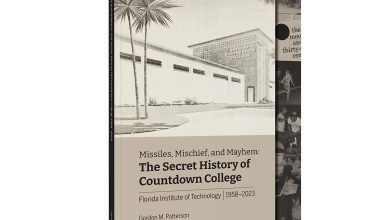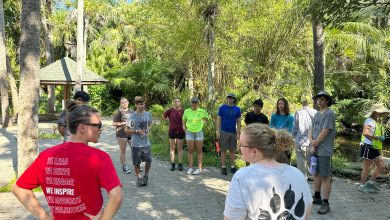Quality Matters: Q&A with Florida Today Journalist Britt Kennerly
How do you give people content they’ll actually pay for?
That’s something Britt Kennerly and I grappled with as we sat down last week to talk about the state of journalism and the new types of media that constantly surrounds us.
Kennerly is the deputy public opinion editor and a columnist at Florida Today. She’s spent decades in the journalism industry and has witnessed the digital evolution in the news industry — a focus shift from print to online publication.
Not long after graduating, Kennerly managed to sell an article to a newspaper for $150 and has been hooked ever since. This is a look into her life as a journalist, and some advice for any aspiring writers: stick with it.
What’s your day-to-day work life like at Florida Today?
Every day might be something different. I’m working on a project about the history of US1. So I’ll be working on that over the next few weeks and we’ll have a seven-week series that starts in September.
So I might spend half a day working on that, three hours working on the letters to the editor, an hour interviewing people for an upcoming column, meetings, we have editorial board meetings, and I might get asked to jump in on something. That’s the beauty of it — no day is ever the same.
But the one thing I have to do every day is fix that letters to the editors package. And that can be a little dicey too. Between Bill Cosby and Donald Trump and the Supreme Court ruling, there has been no shortage of letters or opinions. We’re hoping to attract more millennials and younger boomers into the letter-writing process. For the most part, they’re 65 – 75 and older in Brevard County.
We have a balance of conservative and more liberal writers, and then some that are strictly down the middle, we think, but the readers are convinced it’s either one way or the other.
It seems like many audiences view newspapers as very liberal. How do you deal with that?
We deal with that quite a bit here, actually, because we do have a reputation here for being a liberal newspaper. I could tell you that in others parts of the country where I worked, this would be considered a staunchly conservative paper. We try to work with that balance on the pages, but we also talk with our readers about that. What we do agree on, though, is the freedom to speak your mind and stand up for your values. If we can at least agree on that, then we can go from there.
How long have you been in the journalism industry?
This isn’t a joke — when I was in college, we were still fighting over the really good selective typewriter because we had so few computers. I didn’t become a full-time journalist until 1990, even though for five years before that I was writing for alternative newspapers. I’ve been a paid writer for 30 years, and an actual newspaper journalist for 25.
So you’ve kind of seen the evolution of technology and journalism.
Yes, I’ve definitely seen the evolution. And sometimes now we feel like what we’re being asked to do changes on a weekly basis, because there’s another innovation or there’s a tweak to something we’re using. And there’s much more of that ability to know who your audience is, what they want, and that’s exciting. It used to be that if we just put it out there, and if they wrote you a letter or maybe gave you a phone call, you knew what they were thinking. But now it’s immediate and it’s just amazing, and those of us that have been doing this a long time really like that. There are those who choose to move on because they don’t like that immediacy so much and the pressure of the immediacy that comes with that. It used to be that you had that one headline a day, and now you have a deadline like every minute, because something could happen at any time and we need to be as accurate and quick to get it out there as possible.
Do comments, interactions and the feedback you get influence the content you choose to write about?
It’s funny you mention that, because we started a new thing called “Your Online Views;” it runs on Monday in place of the letters to the editor, because we found out that we get some of our best comments or best input in the comments left on the website on the story itself.
Now we’re seeing voices we’ve never seen before and that in turn, we’re seeing what they’re thinking about, what they’re talking about, what’s important to them. And it might spur another look [at some stories.] Maybe 10 years ago, we would have said “Oh, we’ve written about that to death.” But if they’re still talking about it, it’s worth another look.
What are some of your war stories over the years of dealing with the constantly new technology?
This would be 1997; I was a special sections editor at a newspaper in Indiana, and we were sitting at a table much like this one, a long table, with the publisher and all the editors. I was the youngest one there, and we were talking about our new website. And we were just going to throw all our content onto this new website.
And I’m sitting here thinking ‘wait a minute, if we’re putting all our stuff on this website, and we don’t charge them anything for it, why would they want to buy the print paper?’ And so we had this great discussion, and one of the editors at the table said, “There will never come a day where the print paper will be outshone by this internet thing.”
It wasn’t long after that that the big discussion came, “Should we charge for it?” We all see how well that worked out and how paywalls didn’t come for another dozen years. And when they did, people really balked at paying for content. We still see that all the time, so there’s that constant struggle to give people the best content that they actually will pay for.
Do you think anything is lost in new media?
Maybe some of the quality. I still think there’s a really great need for explanatory journalism. For example, USA Today just did this fantastic project about untested rape kits, and there are just endless stories there. So when you look at what the number one story is, and you see that it’s possibly Buzz Aldrin and John Travolta were in town and that the gallery of photos was more popular by 20 times than something of great importance like the rape kits story, that can be a little disheartening.
I think sometimes because people have so much thrown at them, they have to be picky with their time too. We have so much more to choose from, so we have to be better as a newspaper at knowing what people want. Sometimes it’s disheartening to see what it is they want, if you’re only looking at the numbers. But it isn’t all numbers.
You do lose a little bit of the quality, we can’t do quality in three seconds the way we could in several hours. I think there’s something to be said for taking the best of all of it, and that’s what we do here.
Accuracy is possibly what loses out the most sometimes. Because you have to go in and back-edit it and fix it online, and hope that 9,000 people didn’t see the mistake the first time.
So how do you guys at Florida Today deal with the struggle of what the people want versus what they should want? Or is it just something you’re observing right now?
It is something we’re really still observing, even though we know so much more than we did a year ago. If no one is looking at something, then something is wrong, whether it’s the headline or the lede. And a lot of times it really is as easy as a great headline.
Is there anything else that you want people to know?
Just that quality still matters. Anyone I talk to, it does still matter to them. You as a young journalist can encourage eighth and ninth graders, because those budding writers are out there. Keep encouraging younger journalists. I walk into to talk to people, and you’re not a reporter, you’re the paper. They say “the paper’s here!” and I realize I’m “the paper.” It’s an incredible responsibility and it’s an incredible honor to have people tell you their stories and trust you to tell that story. And so quality does matter, no matter if it has to be a paragraph. Quality matters.





